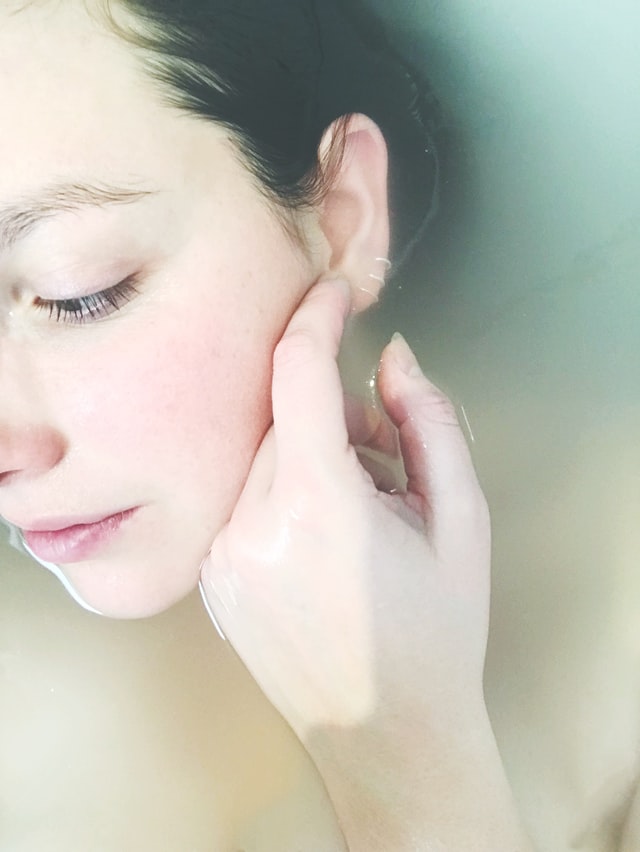To create your ideal monthly exfoliation routine, first determine your skin type: oily, dry, combination, or sensitive. Oily skin might need more frequent chemical exfoliation with salicylic acid, while dry or sensitive skin benefits from gentler lactic acid. Try exfoliating once a week and adjust based on your skin's response. Opt for chemical methods for sensitive skin or physical scrubs for a quicker effect on non-sensitive types. Always follow exfoliation with a hydrating moisturizer and broad-spectrum SPF to protect and nourish your skin. Pay attention to your skin's signals and adjust accordingly to maintain a healthy glow. Discover more about fine-tuning your routine.
Understanding Your Skin Type
Understanding your skin type is essential for tailoring an effective exfoliation routine. By identifying whether your skin is oily, dry, combination, or sensitive, you can optimize your approach to guarantee the best results without causing irritation. If you have oily skin, you might notice a more frequent need for exfoliation due to excess sebum production, leading to clogged pores. On the other hand, dry skin requires a gentler touch, as harsher exfoliation can strip away necessary moisture, leaving your skin feeling tight and uncomfortable.
Combination skin presents its own challenges, as it typically features both oily and dry areas. You'll need to balance your routine by addressing each zone's unique needs. Sensitive skin demands the most care, as it's prone to irritation and redness. Understanding these nuances helps you avoid over-exfoliating and damaging your skin barrier.
Pay attention to how your skin reacts after exfoliating. If you notice excessive dryness, redness, or breakouts, it might indicate you're using the wrong technique or frequency. Your skin can also change with seasons, age, or lifestyle, so reassess your skin type periodically to keep your routine effective and safe.
Choosing the Right Exfoliant
Once you've identified your skin type, selecting the right exfoliant becomes the key to a successful skincare routine. If you have oily skin, consider using chemical exfoliants like salicylic acid. They penetrate deep into your pores, removing excess oil and preventing breakouts. On the other hand, if your skin is dry or sensitive, opt for gentler options like lactic acid or enzymatic exfoliants derived from fruits. These help slough off dead skin cells without causing irritation or dryness.
For those with combination skin, you might want a balanced approach. Use a mix of both AHA (alpha hydroxy acids) and BHA (beta hydroxy acids) to target different areas of your face. AHAs are water-soluble and work on the skin's surface, while BHAs are oil-soluble and penetrate deeper.
If you're dealing with mature skin, glycolic acid, an AHA, can be beneficial. It helps improve texture and reduce the appearance of fine lines. Always pay attention to the concentration of the exfoliant you choose. Start with lower concentrations, especially if your skin is sensitive, and gradually increase as your skin adapts. Remember, choosing the right exfoliant makes all the difference.
Weekly Exfoliation Schedule

When crafting your weekly exfoliation schedule, consider your skin's unique needs and how it reacts to different products. Some people have sensitive skin that requires gentle care, while others may handle more frequent exfoliation. Start by exfoliating once a week and observe how your skin responds. If your skin seems happy and healthy, you might increase to twice a week.
Choose specific days for exfoliation to establish a routine. Many opt for mid-week and weekend sessions, ensuring your skin receives consistent care. Cleansing your face thoroughly before exfoliating is essential. This step removes dirt and oil, allowing the exfoliant to work more effectively. After exfoliating, always apply a nourishing moisturizer to help your skin retain moisture and remain supple.
Be mindful of over-exfoliating, which can lead to irritation and dryness. Pay attention to any signs of redness or discomfort, and adjust your schedule accordingly. Remember, less can be more when it comes to exfoliation. Consistency is key, but your skin's well-being should guide your routine. By listening to your skin and adjusting as needed, you'll maintain a healthy, glowing complexion all month long.
Chemical Vs Physical Exfoliation
The choice between chemical and physical exfoliation can be a journey of discovery for your skin. Understanding the difference between the two methods helps you make better skincare decisions. Chemical exfoliation uses acids or enzymes to dissolve dead skin cells. You'll find products like alpha hydroxy acids (AHAs) and beta hydroxy acids (BHAs) beneficial here. They penetrate your skin's surface, promoting a smoother texture and even tone. Chemical exfoliants are often gentler and can be great for sensitive skin if you choose the right formulation.
On the other hand, physical exfoliation involves manually scrubbing away dead cells with abrasive substances like microbeads, sugar, or brushes. This method gives you instant results by physically removing the outermost layer of your skin. It's effective for those who prefer a more hands-on approach or want to target specific areas.
Both methods have their perks, but it's essential to take into account your skin type. If your skin's sensitive or acne-prone, chemical exfoliants might be gentler and prevent irritation. Meanwhile, if you enjoy a tactile experience and don't have sensitive skin, physical exfoliation could be satisfying. Ultimately, experimenting will reveal what leaves your skin feeling revitalized and glowing.
Seasonal Adjustments

Exploring the best exfoliation method for your skin type sets the foundation for adapting to seasonal changes. As the weather shifts, your skin's needs evolve, making adjustments essential for maintaining a healthy glow. In the colder months, the air becomes drier, which can lead to flaky skin. You might find that reducing the frequency of exfoliation helps, as over-exfoliating can strip away essential oils, leaving your skin even drier. Opt for a gentle exfoliator, perhaps a mild chemical exfoliant, to remove dead skin without causing irritation.
When spring arrives, your skin starts to produce more oil. This is the perfect time to increase your exfoliation frequency slightly to prevent clogged pores. You might want to switch to a more robust physical exfoliant if your skin can handle it. Summer brings increased humidity and sun exposure, so balancing exfoliation with sun protection is key. Focus on lightweight, soothing exfoliants that won't irritate sun-exposed skin.
As autumn approaches, your skin might start to feel a bit dull. Gradually incorporate richer exfoliating products to counteract the changing conditions, preparing your skin for the chill ahead. Adjusting your routine with the seasons guarantees your skin stays radiant year-round.
Post-Exfoliation Care
After exfoliating, your skin resembles a fresh canvas, ready to absorb nourishing products more effectively. To maximize the benefits, immediately follow up with a gentle toner to restore your skin's pH balance. Opt for an alcohol-free formula to guarantee it doesn't dry out your freshly exfoliated skin. Gently pat it onto your face, avoiding any harsh rubbing.
Next, apply a hydrating serum packed with antioxidants or hyaluronic acid. These ingredients replenish moisture and protect against environmental damage. Use your fingertips to gently press the serum into your skin, allowing it to penetrate deeply.
Follow up with a moisturizer to lock in all the benefits. Choose a cream or lotion with soothing ingredients like aloe vera or chamomile, which calm any potential irritation. Applying it while your skin is still damp from the serum enhances absorption.
Lastly, if it's daytime, don't forget sunscreen. Exfoliated skin can be more sensitive to UV rays, so opt for a broad-spectrum SPF of at least 30. Apply it generously to protect your skin from sun damage. This post-exfoliation care guarantees your skin stays healthy, glowing, and well-protected.
Signs of Over-Exfoliation

Over-exfoliation can wreak havoc on your skin, leading to several unmistakable signs. If your skin feels unusually tight, dry, or flaky, you might be removing too much of its natural oils. These oils are essential for maintaining a healthy barrier, so stripping them away can result in an uncomfortable, dry sensation. Another telltale sign is increased redness or irritation; your skin may appear more sensitive than usual and react harshly to products you normally use without issue.
You might also notice a sudden increase in breakouts. While exfoliating is meant to clear pores, overdoing it can actually trigger more acne. This happens because your skin goes into overdrive, producing excess oil to compensate for the loss, which can clog pores and lead to breakouts. Additionally, if your skin starts to appear thin or translucent, it's a clear sign you're over-exfoliating.
Finally, a burning or stinging sensation when applying skincare products is a red flag. Your skin's barrier is likely compromised, making it more susceptible to irritation. Recognizing these signs early can help you adjust your routine, ensuring your skin remains healthy and resilient.
Frequently Asked Questions
How Often Should I Exfoliate Sensitive Skin Each Month?
For sensitive skin, you should exfoliate once per week, totaling about four times a month. Choose a gentle exfoliant to avoid irritation. Listen to your skin; if it reacts negatively, reduce frequency to once every other week.
Can Exfoliation Help Reduce Acne Scars?
Exfoliation can help reduce acne scars by removing dead skin cells and promoting cell turnover. You should choose gentle products and avoid over-exfoliating to prevent irritation. Consistency is key for seeing improvements over time in your skin's texture.
Is It Safe to Exfoliate Before or After Shaving?
Ever wondered if exfoliating before or after shaving is safe? Exfoliate before shaving to remove dead skin cells, allowing for a smoother shave. Post-shave exfoliation can irritate sensitive skin. So, stick to pre-shave exfoliation for best results.
What Are Some Natural Exfoliants I Can Use at Home?
You can use natural exfoliants like sugar, coffee grounds, or oatmeal. Mix them with honey or yogurt for added benefits. They gently remove dead skin cells, leaving your skin smooth and refreshed without harsh chemicals.
How Does Diet Affect Skin's Exfoliation Needs?
Think of your skin like a garden. When you nourish it with a balanced diet, it blooms beautifully, needing less frequent exfoliation. Junk food's like weeds that choke it, prompting more exfoliation to maintain that glow.
At a Glance
In crafting your ideal monthly exfoliation routine, think of your skin as a delicate garden. Choose the right tools and timing—weekly exfoliating keeps it vibrant, while adjusting for seasons guarantees its resilience. Whether you favor chemical or physical exfoliants, remember to nurture with post-exfoliation care. Watch for signs of over-exfoliation; it's like overwatering, leaving your garden wilting. With mindful care, your skin will flourish like a well-tended blossom, radiant and healthy.






